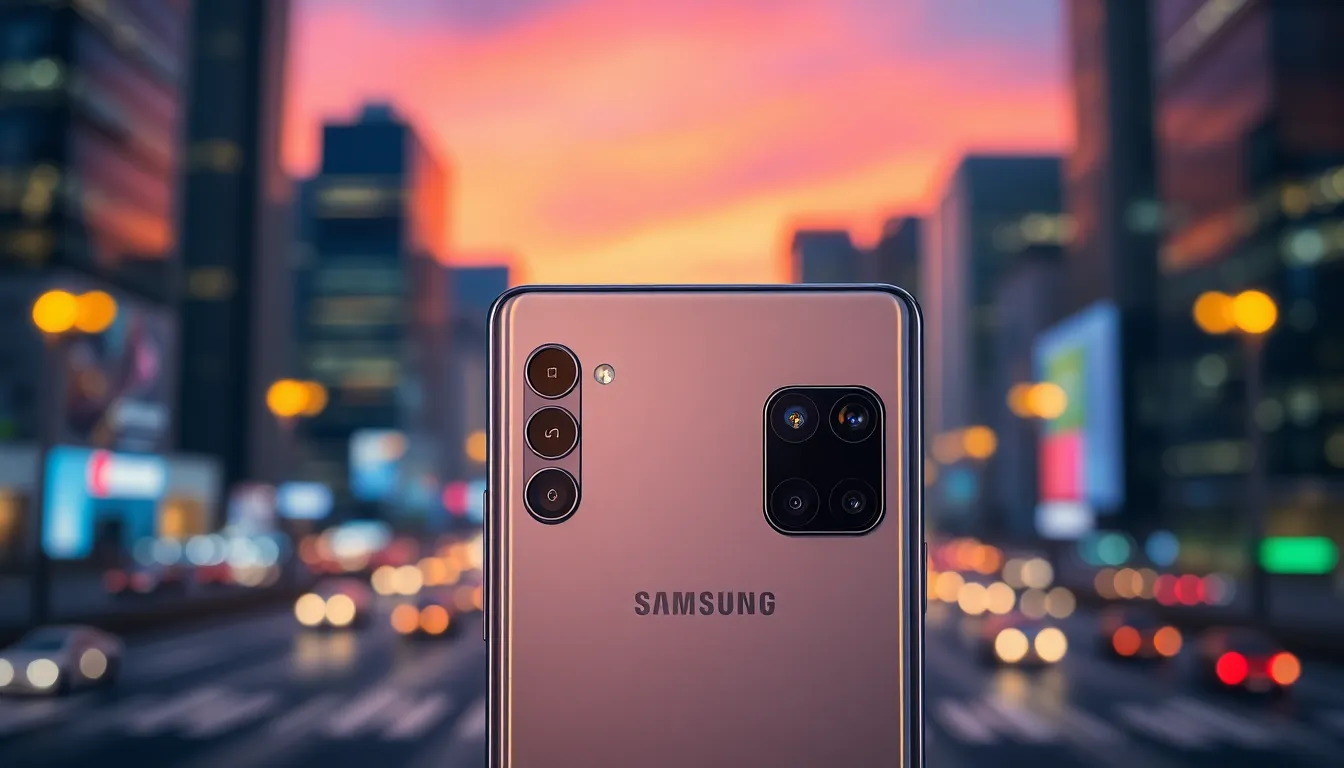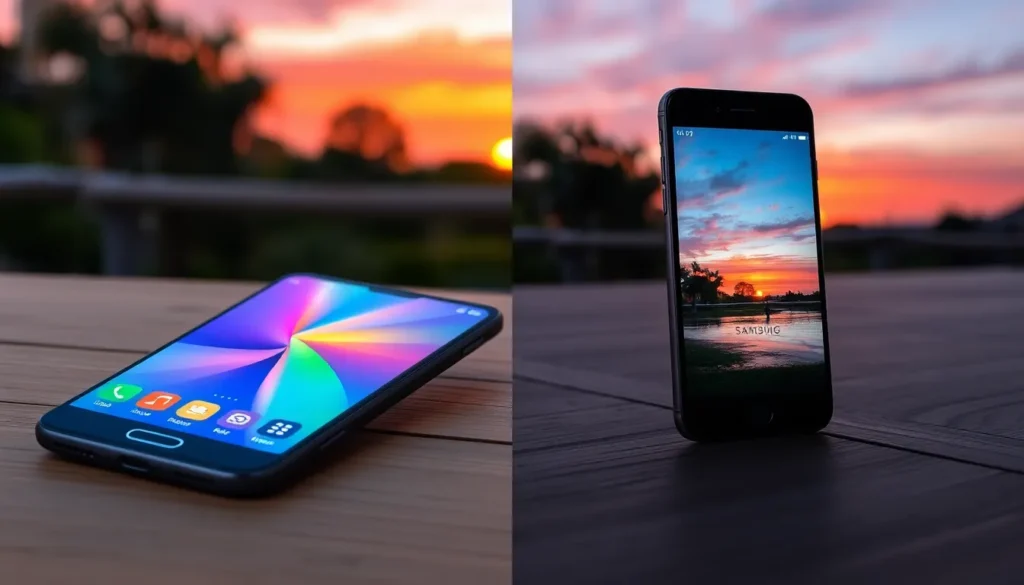Table of Contents
ToggleIn the epic showdown of smartphones, the battle between Samsung and iPhone fans rages on, but one question often takes center stage: does Samsung have a better camera than iPhone? Picture this: you’re at a stunning sunset, phone in hand, ready to capture the moment. But which device will transform that fleeting beauty into a masterpiece?
Overview of Smartphone Cameras
Smartphone cameras play a crucial role in users’ photography experiences. Samsung devices often feature advanced camera technology, offering multiple lenses and high-megapixel sensors. iPhones focus on delivering consistent and user-friendly photography experiences.
Both brands include various features to enhance image quality. For instance, Samsung utilizes impressive low-light capabilities, which results in clearer images in dim lighting. In contrast, iPhones emphasize color accuracy and natural skin tones, ensuring photos reflect reality closely.
Software optimizations also contribute significantly to the performance of these cameras. Samsung invests heavily in image processing algorithms, enhancing detail and dynamic range. Apple’s software delivers efficient HDR processing, producing well-balanced images even in challenging lighting conditions.
Different users may prefer particular camera functionalities. Some gravitate towards Samsung’s versatility, with options such as pro mode allowing manual adjustments. Others appreciate the simplicity and reliability of the iPhone’s automatic settings, which produce great results without much effort.
The addition of video capabilities further distinguishes these devices. Samsung generally supports higher resolutions and frame rates, appealing to those seeking professional-grade videos. iPhones maintain robust video quality with features like Cinematic mode, designed for easy editing and sharing.
Ultimately, users face the choice between the diverse offerings of Samsung and the polished consistency of iPhones. Evaluating preferences, such as photography style and using different environments, becomes essential in determining which brand suits individual needs better.
Key Features of Samsung Cameras

Samsung cameras incorporate advanced technology that significantly enhances user experience. Each camera features multiple lenses, enabling versatile shooting options. High-megapixel sensors contribute to unparalleled image clarity, capturing intricate details.
Image Quality
Images taken on Samsung devices often display vibrant colors and sharp contrasts. Their processing algorithms optimize photo results, enhancing overall quality. Users appreciate the dynamic range these cameras provide, allowing natural transitions from light to dark. Samsung cameras excel in producing photos characterized by vivid saturation and impressive detail retention.
Low Light Performance
In low-light scenarios, Samsung devices demonstrate remarkable performance. They utilize larger sensors and specialized modes, allowing for minimal noise in darker environments. Enhanced image stabilization also improves capture during challenging lighting conditions. Users benefit from clear, usable photos without excessive grain or blur.
Video Capabilities
Samsung smartphones support high-resolution video recording, with options up to 8K at 30 frames per second. This allows filmmakers and content creators to achieve professional-quality footage. Features such as Super Steady help reduce shaking during action shots. The additional frame rate options also give users more creative flexibility for slow-motion videos, showcasing their ability to cater to diverse videography needs.
Key Features of iPhone Cameras
iPhone cameras come with notable features that enhance the photography experience.
Image Quality
Apple emphasizes image quality with a focus on color accuracy and natural skin tones. The Smart HDR feature balances highlights and shadows effectively, ensuring well-lit images in various conditions. Additionally, Photos app enhancements allow for easier editing, offering tools that maintain image integrity. Users appreciate the reliable performance across different scenarios, resulting in vibrant and true-to-life photographs.
Low Light Performance
In low light situations, iPhones utilize advanced Night mode capabilities. This feature activates automatically, capturing more detail and reducing noise without user intervention. Larger sensors contribute to better light absorption, creating clearer images even in darker environments. This design ensures users can take stunning photos in challenging lighting, maintaining quality while offering ease of use.
Video Capabilities
Video recording on iPhones is another highlight, with features like 4K resolution at 60 frames per second. Cinematic mode enhances depth of field, making videos look professional and polished. Image stabilization technology minimizes shakes, allowing for smoother footage during movement. Overall, the combination of these video capabilities enhances the versatility of iPhone cameras, appealing to content creators and casual users alike.
Comparison of Samsung and iPhone Cameras
Evaluating the camera capabilities of Samsung and iPhone reveals distinct strengths in photography. Users often identify their preferences based on specific use cases and features.
Side-by-Side Image Examples
Comparative image examples showcase the differences between Samsung and iPhone cameras. Samsung images typically exhibit vibrant colors and sharp contrasts, enhancing overall visual appeal. In contrast, iPhone photos often reveal superior color accuracy and detail preservation. Users can easily observe how Samsung excels in low-light scenarios, producing images with minimal noise. iPhone, on the other hand, consistently captures natural skin tones and balanced highlights. Side-by-side images can illustrate these nuances effectively, allowing users to make informed choices based on real-world performance.
User Experience and Interface
User experience plays a critical role in camera performance. Samsung’s camera interface offers versatility, with numerous manual settings and customization options. Users appreciate the ability to adjust settings like ISO and shutter speed directly. iPhones provide an intuitive experience, focusing on simplicity and automatic optimizations. The seamless integration of features like Smart HDR enhances user convenience. Many individuals find themselves drawn to the automatic mode of iPhone cameras, which often delivers appealing results without additional effort. The choice between these interfaces depends on individual preferences for control versus ease of use.
Consumer Preferences and Trends
Users express varied preferences when choosing between Samsung and iPhone cameras. Some individuals favor Samsung’s advanced features, appreciating the flexibility of manual controls and multiple lenses. Others prefer iPhones for their straightforward, user-friendly interfaces that simplify photography tasks.
Demographics play a vital role in shaping these choices. Younger users often gravitate toward Samsung for its high-resolution capabilities and dynamic range. They value the ability to capture vivid images in diverse lighting conditions, especially with advancements in low-light technology.
In contrast, older consumers frequently opt for iPhones, valuing consistent results in everyday photography. Familiarity with Apple’s ecosystem influences their decisions, as many find comfort in the seamless integration between devices.
Market trends reveal a growing interest in video capabilities among users. Samsung’s support for higher resolutions, such as 8K video, attracts content creators seeking cutting-edge options. Meanwhile, iPhones gain traction among those prioritizing quality, thanks to features like Cinematic mode that enhance storytelling through video.
Consumer reviews and expert opinions further shape preferences. Enthusiasts often highlight Samsung’s vibrant color reproduction and sharp contrasts, particularly in challenging lighting. Meanwhile, iPhone users commend the realistic skin tones and color accuracy, especially in portrait photography.
Preferences also shift based on social media trends. Platforms like Instagram and TikTok encourage users to showcase high-quality visuals, pushing brands to enhance camera technology continuously. The demand for superior photography experiences fuels innovations, making both Samsung and iPhone viable contenders in the camera department.
The debate over whether Samsung has a better camera than iPhone continues to spark discussion among users. Each brand offers distinct advantages that cater to different photography preferences. Samsung shines with its advanced features and low-light performance while iPhone excels in color accuracy and user-friendly simplicity.
Ultimately the choice between them boils down to personal needs and shooting styles. Users who prioritize versatility and dynamic range may lean towards Samsung. Those who value consistent quality and ease of use might prefer iPhone. As technology evolves both brands will likely continue to innovate ensuring that users have exceptional camera options at their fingertips.







